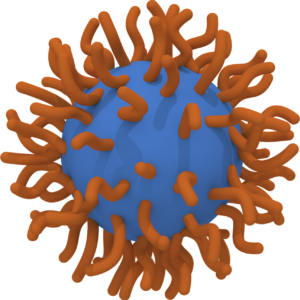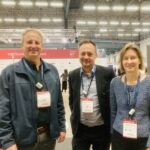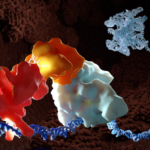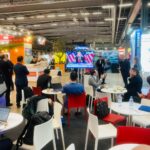Bildnachweis: anatolir – stock.adobe.com, TOPAS Therapeutics GmbH, Topas Therapeutics GmbH.
What drives an experienced biotech leader to join a company like TOPAS, and why does he believe that they’re an undiscovered gem in the field of autoimmune treatments? We spoke to CEO Mr. Hugo Fry at BIO-Europe in Stockholm about groundbreaking technology, strategic challenges, and the future of immune tolerance.
Plattform Life Sciences: Mr. Fry, you’ve once described yourself as a biotech veteran, because of your 30 years of experience and long professional journey that includes companies like Imbria, 20Med, RQ Biotechnology, and Sanofi, to name a few. You’ve worked in the U.S., the Netherlands, the U.K., and since 2022 in Germany. In May 2024, you joined TOPAS as CEO. What motivated you to take this step, and what excites you about the company?
Autoimmune diseases are an area that is currently driving tremendous interest in the biotech industry. TOPAS is developing an innovative modality for inducing tolerance, a truly groundbreaking and innovative technology. We believe that there are currently only 4 – 5 companies working on this kind of technology and I wanted to be part of that journey and help bring this unique approach to life.
And what were the factors that convinced you to join beyond TOPAS’ scientific approach?
The key factor was the scientific approach but in addition to that, the stage of development was also important. It is a rare opportunity to combine cutting edge innovation with a data readout from a phase 2a clinical trial on the horizon. When I joined TOPAS the data was expected in the next 7 months.
Could you briefly explain the scientific background of TOPAS, particularly your platform technology, TOPAS Particle Conjugates?
TOPAS‘ platform, which is built on a significant amount of intellectual property, has innovative nanoparticles at its core, which enable an extremely targeted approach to treating diseases. The key is understanding the antigens driving the disease. By targeting specific cells in the liver, known as liver sinusoidal endothelial cells (LSECs), these nanoparticles induce tolerance by stimulating the body’s natural immune response. Essentially, this process helps “normalize“ T-cells, which are typically responsible for attacking the body’s own tissues in autoimmune diseases. Once the antigen is understood and identified, the corresponding peptide is linked to our nanoparticles. These particles then travel through the liver, which acts as a central organ for this process and induces tolerance toward the coupled antigen, thereby leading to therapeutic effects in affected tissues and the induction of systemic tolerance. This highly targeted mechanism enables us to address the underlying cause of autoimmune diseases in a precise and controlled manner. This technology allows for a level of specificity that we believe is a major breakthrough in the field.
How do patients typically react to a treatment based on the mechanisms you’ve described? Of course, this can vary depending on the disease and the patient, but in general, are there any side effects?
In terms of side effects, patients do experience clinical responses, as expected with any treatment presenting disease-specific antigens to the body. However, it’s important to note that this response is a reaction linked to the disease itself, rather than solely a side effect of the treatment. The body’s natural immune processes are stimulated, so the response may reflect how the body is reacting to the underlying condition upon treatment with a tolerizing agent. Each patient may react differently, but overall, we aim for a targeted and controlled immune response, with the goal of inducing tolerance to the disease.

How long does it take for the treatment to show effects?
In our clinical trial, we administered two doses to the patients two weeks apart. We measured the effects one week after the second dose, and up to three weeks later. For our celiac disease candidate, we observed positive results. The effectiveness was appreciated through circulating and antigen-specific cytokine responses, such as IL-2, IL-10, and interferon-gamma. Of course, we also monitored the symptoms via patient reported outcomes to assess the overall impact of the treatment.
So, the treatment period you focus on is only about 3-5 weeks? What are the long-term results and effects? Does the patient need further treatment after these two doses, or can they be considered cured?
Subsequent clinical trials, particularly the upcoming Phase 2b and 3 studies, will provide insights into long-term outcomes. Currently, we know that the treatment showed promising, persistent effects throughout the initial phase 2a trial, which included 37 patients. However, we still need to understand the optimal dosing frequency and maintenance regimen. These next Phase trials will help us determine the best approach for long-term effectiveness and whether ongoing treatment is necessary for sustained results.
At what stage of the disease can the medication be used? Is your treatment only suitable for early-stage diseases, or can it also be applied to later-stage conditions?
The stage of the disease certainly depends on the specific condition. For celiac disease, timing of administration does not really matter, because the immune response mechanism we target can still be effective at various stages of the disease. However, for indications like type 1 diabetes, it is crucial to begin treatment very early. Early intervention is important to prevent further immune damage and to achieve better outcomes in terms of inducing tolerance.
And is the goal to achieve total remission with this treatment?
On October 15th, 2024, we announced positive topline data from our Phase 2a study of our lead candidate, TPM502, for celiac disease, which involved 37 patients. Celiac disease is our primary indication, and the study demonstrated early proof-of-concept for our platform. In addition to this, we also conducted a Phase 1 trial for pemphigus vulgaris, a different autoimmune disease. In that trial, we demonstrated the treatment’s safety and tolerability, and we observed some early signs of tolerance induction. The versatility of our platform allows us to apply the data we gather from one disease, like pemphigus, to others, like celiac disease, and seamlessly transition from Phase 1 to Phase 2 trials. While remission is the ultimate goal, further studies are needed to fully understand the long-term potential of the treatment.
How is your company financed? You raised €18 million in total in a Series A round and later raised €22 million in a Series B funding in 2021, bringing the total to €40 million. How long will this funding last, and what have you used the funds for so far? What is the stance of your investors, such as BioMedPartners, Boehringer Ingelheim Venture Fund, EMBL Ventures, Epidarex Capital, Evotec, Gimv, and Vesalius Biocapital, who all participated in the extension round?
We are fortunate to have brilliant investors on board. With the funds we raised, we are well-financed by our current investors until the end of 2025. The financing has been crucial in advancing our clinical trials, particularly for celiac disease, as well as in further developing our platform technology. Our investors remain highly supportive, and their continued commitment is a testament to their confidence in our progress.
Financed until 2025 – that’s a pretty short time, right?
Yes, it’s true that we have about twelve months left, but there is still plenty of time to make significant progress. And the key point is that we recently generated very strong data to work with. This gives us sufficient time to either secure a strategic partner or raise additional financing to continue independently. We’re not committed to one option yet, but we will continuously assess the different options and how they align with our corporate goals. What’s crucial is that we first need to build a competitive position in the market. Once we show that we can create value and demonstrate our platform’s potential – and we will – both current and new investors will be more inclined to become further involved. Pharma companies typically view our progress at Phase 2a and assess the risk involved in partnering with us. They will evaluate whether to wait for additional data or to engage now, before the company’s valuation increases further. If they decide to wait, they might miss the opportunity to enter at a lower valuation. On the other hand, investors are looking for opportunities to maximize returns. If they believe that by supporting us now, they can help build the company to a point where its value will increase substantially, they may decide to invest (more) now. Ultimately, the pharma industry and our investors both play a key role in deciding the company’s future direction. Our job is to demonstrate the value we’re creating so that we can secure the right partnerships and financing to drive our growth forward. At the end, as a company, you are navigating the competition between investors and pharma to maximize the value of the company.
Well, still a short time for playing. Only 2025 and „that’s it!“ for a lot of companies… But wasn’t it the case in recent years that companies had longer-lasting financing?
Yes, that’s true, especially when companies only have had data readouts and were still working to demonstrate proof of concept. If you don’t have solid data to show, it can be difficult to secure long-term financing. It was already the case before, but it has now become even more pronounced. But in our case, we do have data – and the data is quite persuasive. As I mentioned in the beginning, In the field of immune tolerance, only about 4 to 5 companies are pursuing similar approaches. Of those, only 3 are currently in the clinic. None of them have made it past Phase 2. What we’re doing represents a genuine innovation. Some of our competitors include companies like COUR and Anokion, but we are confident that our approach stands out because we’ve already demonstrated the ability to show symptomatic clinical benefits and a persistent effect in a way others haven’t. We’ve shown two key things that, to my knowledge, others haven’t been able to demonstrate yet. One of the things that sets us apart is the persistent effect of our treatment. Additionally, we are already showing symptomatic clinical benefits tied to patient reported outcomes … and these results are observed immediately after treatment. This gives us a unique advantage and helps build investor confidence, as the data clearly demonstrates the potential of our platform.
So, you say 12 months is enough. What are the next strategic steps for the company during this time?
From a corporate perspective, we are focused on fundraising and finding strategic partners. In parallel, we’re preparing to transition from phase 2a to phase 2b and 3 for our celiac disease treatment. We’re also planning to bring our type 1 diabetes treatment into the clinic. There’s also another aspect of our platform that we haven’t discussed much yet. It’s designed to support cell and gene therapy by addressing the issue of anti-drug antibodies. When you can induce tolerance in T-cells, you can prevent or stop these immune reactions. Right now, there’s no way to do this effectively. In fact, 80% of cell and gene therapy patients rely on high doses of immune suppressors. By solving this unmet need, we could make a significant impact in this field. This could be a potential carve-out of our platform, but we haven’t fully promoted and decided on it yet. But… it has the potential to be another game-changer for the company.
Despite that outlook, what’s your Plan B if finding investors or partners doesn’t work out as wanted? Now, it seems like everyone is holding back their money.
We’re currently in discussions with at least three major pharmaceutical companies that have shown strong interest in our platform. However, they haven’t made any concrete offers yet, especially since this was before we released our Phase 2a data for celiac disease. In terms of investors, we are in ongoing conversations with key industry investors in both Europe and the US. We have built a strong foundation with investors from all over the world – Germany, the US, UK and Belgium. To fund our next bigger trials, we’re also engaging with a broader international network. But we still believe we’re an undiscovered gem, and we have a lot of potential that hasn’t yet been fully realized by the market.
When can we expect more news regarding your clinical outcomes?
We will be releasing new data from the Phase 2a study in celiac disease patients, including patient reported outcomes at a scientific conference in 2025. In addition, we look forward to providing updates on the broader potential of our tolerance inducing platform.
What was your impression of the BIO-Europe conference?
This was the biggest and the best BIO-Europe that I have attended. It is growing in size and importance, with almost all strategic pharmaceutical companies having a significant presence in Stockholm. TOPAS participated in 36 high-quality, productive meetings. TOPAS attended meetings during the three days which is a sign of the benefit of BIO-Europe and the quality of the scientific value proposition that TOPAS is proposing.
Autor/Autorin
Urs Moesenfechtel, M.A., ist seit 2021 Redaktionsleiter der GoingPublic Media AG - Plattform Life Sciences und für die Themenfelder Biotechnologie und Bioökonomie zuständig. Zuvor war er u.a. als Wissenschaftsredakteur für mehrere Forschungseinrichtungen tätig.








